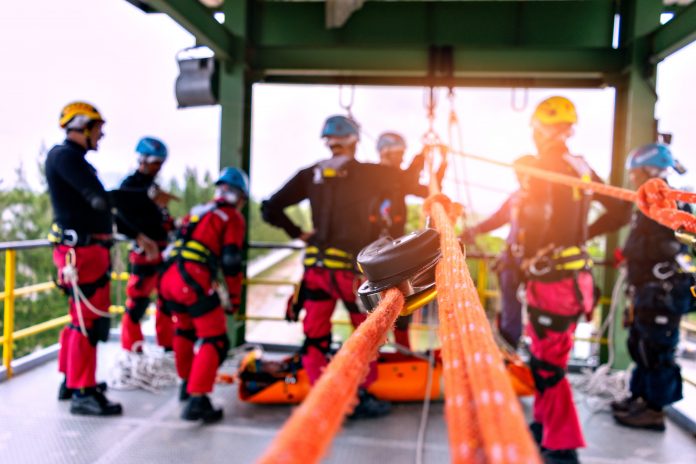
At the end of 2020, the Bureau of Labor Statistics (BLS) released its report summarizing the final data from the 2019 Census of Fatal Occupational Injuries. The number of fatalities and workers both increased, resulting in a steady annual fatal injury rate, highlighting the importance of safety training.
When safety training, and safe practices, are implemented, employees are aware of how to create a safe and happy working environment.
Meeting and Maintaining OSHA Compliance
Since April 1971, the Occupational Safety and Health Administration (OSHA) has worked to ensure “safe and healthful working conditions for working men and women by setting and enforcing standards and by providing training, outreach, education, and assistance.”
The impacts of safety training since OSHA’s creation are undeniable. Worker injuries and illnesses dropped from 10.9 per 100 workers in 1972 to 2.8 per 100 workers in 2019.
With few exceptions, employers in the United States fall within OSHA’s jurisdiction, often making those standards the first place companies look when training their employees.
OSHA has published nearly 1,000 standards in four main categories: Construction, Maritime, Agriculture, and General Industry. However, when determining your company’s enforcement standards, you should think about the potential employee hazards rather than simply exploring industry regulations.
For instance, construction employees may need training in bloodborne pathogens (BBP) for first-aid purposes. However, you will not find the regulation in the Construction section; BBP falls under General Industry.
Taking Control of Safety

Over time, occupational health and safety (OHS) has become more about prevention and hazard identification.
OHS experts have started focusing on educating employees and identifying potential issues instead of managing damage. Prevention-based approaches help companies save the time and money that comes with workplace accidents.
A job hazard analysis (JHA) helps a company identify and correct potential workplace dangers. Conducting a JHA will help you understand dangers in your workplace and how to reduce or eliminate the likelihood of mishaps.
Putting Safety into Practice
From his first day on the job in 1987, Paul O’Neill wanted his company, Alcoa, to be the world’s safest. The only acceptable rate of accidents in his mind was zero.
Alcoa’s goal of minimizing—or eliminating—work injuries makes sense from a personal perspective and a business perspective. In 2020, workplace injuries cost employers $59.59 billion in workers compensation costs and in 2019, resulted in more than 105 million lost days of work.
Before 1987, nearly every Alcoa plant had at least one worker accident per week. After implementing O’Neill’s new safety plan, author Charles Duhigg noted that “some facilities would go years without a single employee losing a workday due to an accident.”
Safety Starts at the Top
For workplace safety to be effective, education and implementation must start at the top. Employees are likely to follow proper procedures if management and safety workers lead by example. Here are four steps you can take to create a safe working environment.
1. Educate all workers
Along with workplace-specific hazards and procedures, there are general safety topics every employee should be trained on.
For example, in 2019, slips, trips, and falls caused 792 worker deaths. Completing a fall safety course can help employees identify fall hazards and how to minimize or eliminate those hazards.
2. Ensure workers use the proper safety equipment
No matter the job, personal protective equipment (PPE) can help protect affected workers, from hard hats and gloves to protective boots and full-body covers.
Under OSHA requirements, almost always, employers are responsible for paying for necessary PPE items. Additionally, the employer must ensure all PPE is in safe working condition and that each employee can properly use the equipment.
3. Empower your employees
Even when employers set up workplaces for safety success, employees must ensure safe habits are being practiced, as they are likely to see potential issues.
One way to empower employees is to implement a Stop Work Authority (SWA). This policy allows for some employees to identify an unsafe situation and gives them the power and obligation to stop work before an incident happens.
Employees also should be encouraged to conduct safety checks of their areas to ensure standards are being met by workers. Giving power to employees helps foster a culture of safety from the ground up.
4. Don’t forget the basics
Along with typical job hazards, you also should consider ergonomics, which can increase productivity and reduce discomfort. OSHA offers guidance on many ergonomic topics such as repetitive motions or excessive heavy lifting.
Training Today’s Employees

The generation raised on technology makes up more than 50 percent of the global workforce, changing many training techniques. A significant change regarding training is mobile-optimized content. After all, 93 percent of Millennials and 90 percent of Gen Xers now own a smartphone.
Mobile devices allow training to be available any time, and anywhere, but the content must function as well as a desktop computer. Think about visiting a Website on your computer versus on your phone. The look, feel, and overall usability must match in order to provide the best experience.
As society becomes more mobile-first, we thrive on short interactions, meaning training must be engaging from beginning to end. Users are more likely to stay involved in a training video lasting 5-15 minutes than in a longer lecture.
Microlearning, or short learning modules, suit today’s learners very well. They are as short as three minutes, and leave out any unnecessary “filler” content.
Take Advantage of Remote Training
During this uncertain time, with employees working from home or temporarily not working at all, microlearning could be an ideal asset. Offering courses in short bursts of time means employees would not need to commit a large portion of their day to training, which can be difficult when working from home.
For more than 20 years, SafetySkills has incorporated important OSH and HR topics into mobile-friendly, interactive training courses, with more than 270 microlearning courses available. See how SafetySkills makes occupational health and safety training easy, no matter your industry, job title, or location.




